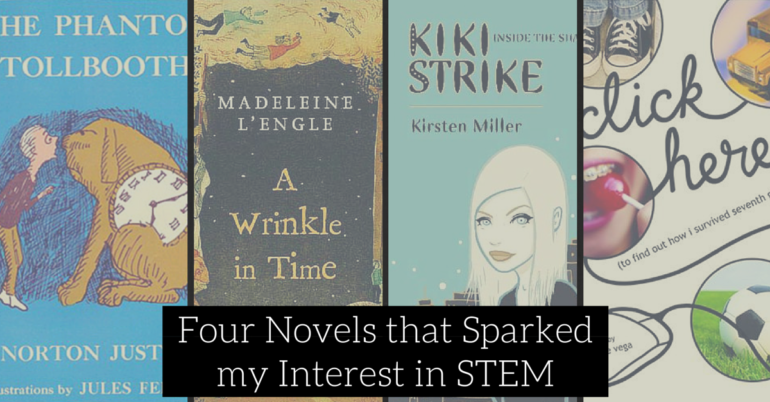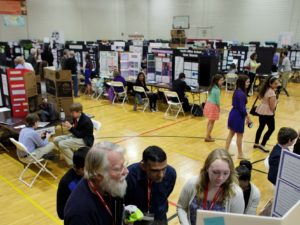
When I was growing up and first reading chapter books, my father would come home with a bag of novels from the bookstore, lay them out on the dining room table, and have me pick out which one we would read together that month. Although I didn’t recognize it at the time, I now see how my father, a software engineer, was often buying books about STEM. As I got older, I started picking out these types of books on my own, coming back from the public library with a classic teen-girl drama novel in one hand and a thick science-fiction book in the other. Looking back, I am incredibly appreciative of his book choices and how they ignited my STEM interest at a young age.
Research has shown time and time again that reading expands children’s imagination of what is possible in the world and possible in their own personal lives. I am especially grateful that I was reading about children in STEM, instead of novels focusing on adults. It allowed me to see how STEM could be accessible and exciting at a young age, and that it wasn’t only grown adults who could pursue curiosity through STEM. By reading children’s and young adult books where STEM impacted the storyline, I grew up seeing STEM as a way to pursue adventure, innovation, and the great unknown.
There are hundreds of excellent young adult novels with STEM featured, but here are my four favorite STEM novels that have stuck with me throughout the years.
The Phantom Tollbooth: Algebra as creating adventure
One of the first chapter books I remember reading with my father was The Phantom Tollbooth, written by Norton Juster in 1961. The book follows the adventures of Milo, a schoolboy who discovers a mysterious package that leads him to an unknown land: the Kingdom of Wisdom. Milo can only continue exploring the Kingdom of Wisdom by understanding how language, numbers, and logic are critical to the world. Literalism is central to the novel; for example, after Milo makes a decision without much reason or thought behind it, he suddenly jumps onto the Island of Conclusions. Along his journey, Milo learns about mathematical concepts in order to overcome the “subtraction stew” or find places like “the land of Infinity, where the tallest, the shortest, the biggest, the smallest, and the most and the least of everything are kept.” The book is intended for a younger audience, so it was the first time I had heard about more complex math concepts. After my father and I read each chapter, I asked him to explain of the math terms or ideas I found confusing, and then he would go into greater depth about each one and how they have real-life applications.
Space exploration, physics, and science fiction in A Wrinkle In Time
Not long after, my father and I read another children’s novel classic, A Wrinkle In Time by Madeleine L’Engle. In A Wrinkle In Time, a group of intelligent misfits explore and save the cosmos by “wrinkling time” using the fifth dimension: a tesseract. As one of the character’s explains, a tesseract can be added “to the other four dimensions and you can travel through space without having to go the long way around…To put it into Euclid, or old-fashioned plane geometry, a straight line is not the shortest distance between two points.” The book isn’t mathematically accurate, since a tesseract is actually the fourth dimension in geometry, and A Wrinkle In Time uses time as the fourth dimension and a tesseract as the fifth dimension. Despite its occasional mathematical inaccuracy, however, the novel was fundamental in sparking my interest in physics and math. After I finished reading A Wrinkle In Time, I spent hours researching information about tesseracts, the dimensions, parallel universes and space exploration. Suddenly, STEM was a gateway to exploring unknown galaxies, and I wanted to understand every possibility that could exist.
STEM girl geniuses in Kiki Strike: Inside the Shadow City
In Kiki Strike: Inside the Shadow City, six young girls investigate the underground tunnels of Manhattan, built during Prohibition and sealed off for three-quarters of a century. To access and explore this uncharted territory, a diverse team of Girl Scouts gone rogue is assembled. The Irregulars, as they call themselves, consists of an electrical engineer, chemist, computer hacker, a master of disguise, a librarian and martial arts expert, all of whom are just 13-years-old. Despite their age, three of the women are geniuses in their STEM fields of engineering, chemistry, and computer science, consistently out-smarting adults and other hurdles in their path. Some of their achievements are fairly unrealistic, such as downloading confidential government blueprints, but other times, the girls simply think on their feet and find innovative and practical STEM solutions. One of the first Irregulars the reader meets, Luz Lopez, catches a neighbor’s vandalism confession, reporting to her former Girl Scout troop, “I found an old baby monitor in the trash outside my building, and with a few adjustments, I was able to convert it into a short-range bugging device.” Kiki Strike: Inside the Shadow City was formative because, although I did not want to use STEM for potentially illegal activities like the Irregulars, they proved how paying attention in class could later get you out of a sticky situation. STEM skills weren’t just handy for understanding new galaxies; they could help me find adventure right in my own city.
Click Here (To Find Out How I Survived Seventh Grade): The book that inspired me to code
Lastly is one of the books that impacted my life most: Click Here (To Find Out How I Survived Seventh Grade). The novel follows the story of Erin, a seventh-grader who designs and codes her own private blog to journal about her middle school experiences, as well a school website. Things go awry when her private blog accidentally gets published to the student body instead of the school website, and Erin must face the repercussions. Erin is not only a talented coder, but also a sharp-witted, slightly-awkward, and generally relatable character. When another student complains about having Erin as a group leader, Erin retorts back that he can “p align” himself to another group, referring to HTML code for positioning an item on a page. Click Here inspired me to start my own blog and learn HTML/CSS, launching my career in website and mobile application product design. Often, STEM is stereotyped as being so based in logic and research that it is devoid of creativity. However, Erin illuminated how coding could be expressive and exciting for a young person to learn.
Whether you are a parent or teacher looking to recommend new books to young people, or a student yourself in need of a fresh novel to read, I always advise including STEM-based books in reading lists. For myself, these books led me to a passion and career in technology, so you never know how novels can shape someone’s life.







